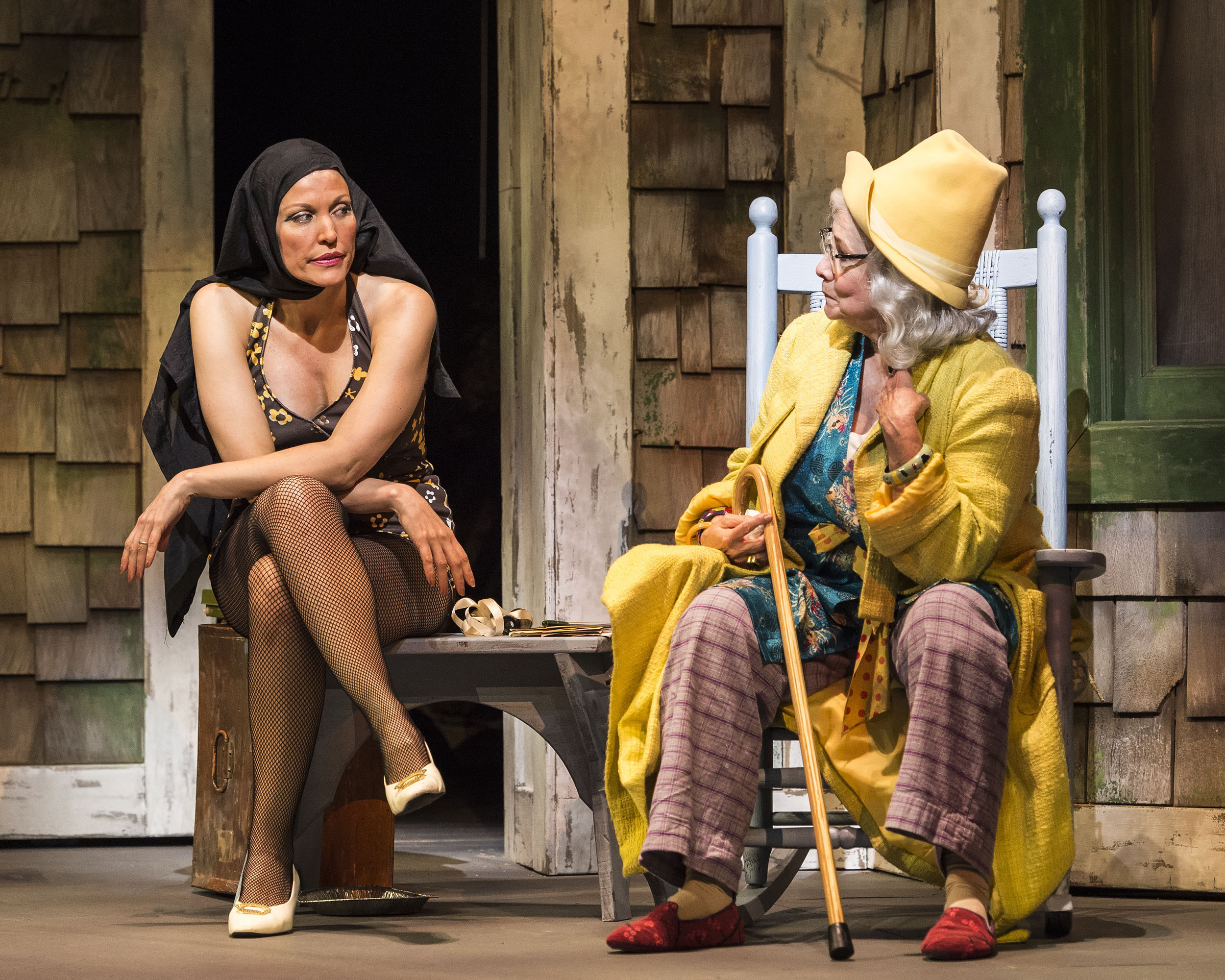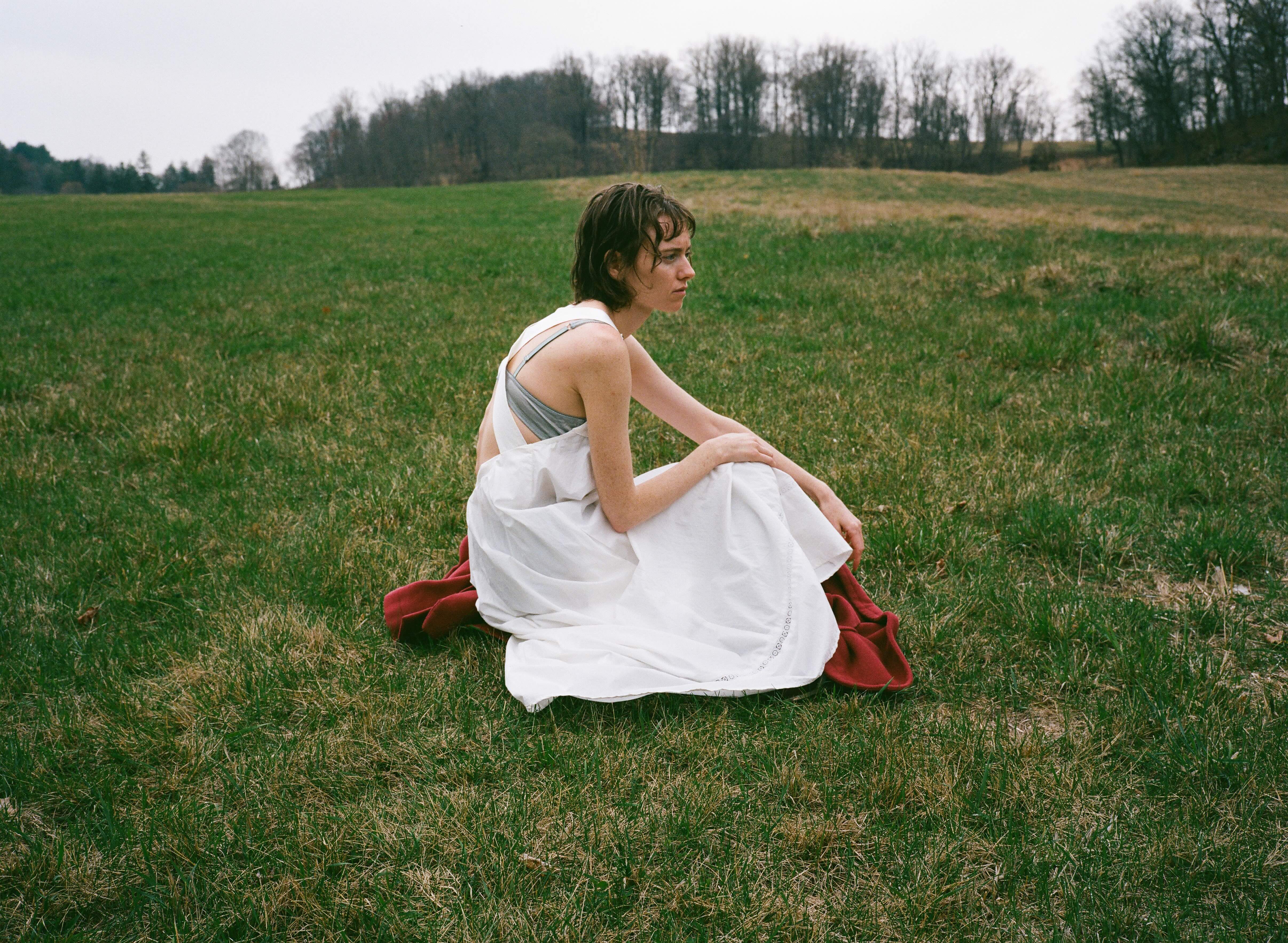

"It's very difficult to keep the line between the past and the present"
Grey Gardens is one of the truest American gothics. The 1975 independent documentary follows Edith "Little Edie" Bouvier Beale and Edith "Big Edie" Ewing Bouvier Beale after the mother and daughter duo holed up in their Hamptons house, struggling to keep a line drawn starkly between their wealthy past and eccentric, reclusive present. The film is a fascinating documentation of the decline of the American aristocracy, but perhaps more so, it is a sensitive and elaborate portrait of two performative women in born into circumstances that rejected them, living out their lives on a stage they crafted for themselves.
Enter the musical rendition of the tale, which opened July 13th at the Ahmanson Theater in L.A. A single actress, Rachel York, plays Little Edie in the first act of the musical and Big Edie in the second act. The first act takes place in a period of time before the documentary was shot, setting the stage for the women's tumultuous yet unbreakable relationship, while the second focuses on the span of time covered in the documentary: the women talking, eating, existing in an everyday capacity.
The translation of the documentary for the stage is a remarkably smooth one. Between acts and set changes, clips from the documentary are played onstage, and the seamlessness between the recorded history and actors' portrayal is striking. Many of the documentary's most memorable lines ("they didn't realize they were dealing with a staunch character," "Mother wanted me to come out in a kimono, so we had quite the fight," etc.)
"That's what we derived our material from — all from the documentary," says York.
Also seamless was York's transition from Big Edie in Act 1 to Little Edie in Act 2. "A lot of it was studying the documentary and several books that I read. Just having these different angles on the character, I was able to sift through. I tried to honor these women as best I could. I don't have a lot of material of Big Edie as a younger woman, so I had to take everything, her mannerisms and the information that I derived from these sources and create the woman in her 40's... when I find their voice inside of me, everything kind of naturally unfolds."
Some people claim the documentary is exploitative of the Edies, but this take seems dismissive of two incredibly performative women who were not allowed to behave as such in their time — and gave them the public platform that they always wanted. York is quick to confirm this theory: Little Edie apparently was thrilled at the prospect of "making a movie." She understood that it was a documentary, but this was a new concept at the time. She would go to premieres with the directors to show those who thought the film was exploitative that she stood in solidarity, that she was thrilled with the outcome of the project.
"She loved the film," York tells me, "she only wished that she had costumes, like in a real film, that she didn't have to put together costumes with whatever was in her closet — she didn't realize she was this amazing designer!"
York also believes that these women are often misclassified as insane. "They were in terrible circumstances, and they were codependent, and they were reclusive. But they did have friends, and Little Edie got out every so often to go to some of the premieres for the show." She also says that refusing to write off the women as crazy allowed her to approach the role with an immense amount of empathy: "I can't play a character like that; I can't play a character insane. I have to find out how they tick. When you look at everything, there were reasons why they fed the raccoons, so they wouldn't jump on them and take their own food. There were a litter of cats that Edie claims that they dropped into their cellar, and they loved cats, so they cared for them."
Perhaps one of the most compelling elements that the musical brings to the story is an additional layer of performance. Actors play women playing parts for the cameras — and a film crew onstage never lets the audience forget the embedded journalists in the women's lives. York says this was an important component to include in the musical.
"They were artists in their hearts, so when I camera comes around... they felt they were terribly talented! So when a camera is put in front of them, of course they're going to perform for you."
#### Grey Gardens the Musical will be playing [at the Ahmanson Theater through August 14th.](https://www.centertheatregroup.org/tickets/ahmanson-theatre/2015-16/grey-gardens/) No staunch character should miss it.
 
"It's very difficult to keep the line between the past and the present"
Grey Gardens is one of the truest American gothics. The 1975 independent documentary follows Edith "Little Edie" Bouvier Beale and Edith "Big Edie" Ewing Bouvier Beale after the mother and daughter duo holed up in their Hamptons house, struggling to keep a line drawn starkly between their wealthy past and eccentric, reclusive present. The film is a fascinating documentation of the decline of the American aristocracy, but perhaps more so, it is a sensitive and elaborate portrait of two performative women in born into circumstances that rejected them, living out their lives on a stage they crafted for themselves.
Enter the musical rendition of the tale, which opened July 13th at the Ahmanson Theater in L.A. A single actress, Rachel York, plays Little Edie in the first act of the musical and Big Edie in the second act. The first act takes place in a period of time before the documentary was shot, setting the stage for the women's tumultuous yet unbreakable relationship, while the second focuses on the span of time covered in the documentary: the women talking, eating, existing in an everyday capacity.
The translation of the documentary for the stage is a remarkably smooth one. Between acts and set changes, clips from the documentary are played onstage, and the seamlessness between the recorded history and actors' portrayal is striking. Many of the documentary's most memorable lines ("they didn't realize they were dealing with a staunch character," "Mother wanted me to come out in a kimono, so we had quite the fight," etc.)
"That's what we derived our material from — all from the documentary," says York.
Also seamless was York's transition from Big Edie in Act 1 to Little Edie in Act 2. "A lot of it was studying the documentary and several books that I read. Just having these different angles on the character, I was able to sift through. I tried to honor these women as best I could. I don't have a lot of material of Big Edie as a younger woman, so I had to take everything, her mannerisms and the information that I derived from these sources and create the woman in her 40's... when I find their voice inside of me, everything kind of naturally unfolds."
Some people claim the documentary is exploitative of the Edies, but this take seems dismissive of two incredibly performative women who were not allowed to behave as such in their time — and gave them the public platform that they always wanted. York is quick to confirm this theory: Little Edie apparently was thrilled at the prospect of "making a movie." She understood that it was a documentary, but this was a new concept at the time. She would go to premieres with the directors to show those who thought the film was exploitative that she stood in solidarity, that she was thrilled with the outcome of the project.
"She loved the film," York tells me, "she only wished that she had costumes, like in a real film, that she didn't have to put together costumes with whatever was in her closet — she didn't realize she was this amazing designer!"
York also believes that these women are often misclassified as insane. "They were in terrible circumstances, and they were codependent, and they were reclusive. But they did have friends, and Little Edie got out every so often to go to some of the premieres for the show." She also says that refusing to write off the women as crazy allowed her to approach the role with an immense amount of empathy: "I can't play a character like that; I can't play a character insane. I have to find out how they tick. When you look at everything, there were reasons why they fed the raccoons, so they wouldn't jump on them and take their own food. There were a litter of cats that Edie claims that they dropped into their cellar, and they loved cats, so they cared for them."
Perhaps one of the most compelling elements that the musical brings to the story is an additional layer of performance. Actors play women playing parts for the cameras — and a film crew onstage never lets the audience forget the embedded journalists in the women's lives. York says this was an important component to include in the musical.
"They were artists in their hearts, so when I camera comes around... they felt they were terribly talented! So when a camera is put in front of them, of course they're going to perform for you."
#### Grey Gardens the Musical will be playing [at the Ahmanson Theater through August 14th.](https://www.centertheatregroup.org/tickets/ahmanson-theatre/2015-16/grey-gardens/) No staunch character should miss it.

"It's very difficult to keep the line between the past and the present"
Grey Gardens is one of the truest American gothics. The 1975 independent documentary follows Edith "Little Edie" Bouvier Beale and Edith "Big Edie" Ewing Bouvier Beale after the mother and daughter duo holed up in their Hamptons house, struggling to keep a line drawn starkly between their wealthy past and eccentric, reclusive present. The film is a fascinating documentation of the decline of the American aristocracy, but perhaps more so, it is a sensitive and elaborate portrait of two performative women in born into circumstances that rejected them, living out their lives on a stage they crafted for themselves.
Enter the musical rendition of the tale, which opened July 13th at the Ahmanson Theater in L.A. A single actress, Rachel York, plays Little Edie in the first act of the musical and Big Edie in the second act. The first act takes place in a period of time before the documentary was shot, setting the stage for the women's tumultuous yet unbreakable relationship, while the second focuses on the span of time covered in the documentary: the women talking, eating, existing in an everyday capacity.
The translation of the documentary for the stage is a remarkably smooth one. Between acts and set changes, clips from the documentary are played onstage, and the seamlessness between the recorded history and actors' portrayal is striking. Many of the documentary's most memorable lines ("they didn't realize they were dealing with a staunch character," "Mother wanted me to come out in a kimono, so we had quite the fight," etc.)
"That's what we derived our material from — all from the documentary," says York.
Also seamless was York's transition from Big Edie in Act 1 to Little Edie in Act 2. "A lot of it was studying the documentary and several books that I read. Just having these different angles on the character, I was able to sift through. I tried to honor these women as best I could. I don't have a lot of material of Big Edie as a younger woman, so I had to take everything, her mannerisms and the information that I derived from these sources and create the woman in her 40's... when I find their voice inside of me, everything kind of naturally unfolds."
Some people claim the documentary is exploitative of the Edies, but this take seems dismissive of two incredibly performative women who were not allowed to behave as such in their time — and gave them the public platform that they always wanted. York is quick to confirm this theory: Little Edie apparently was thrilled at the prospect of "making a movie." She understood that it was a documentary, but this was a new concept at the time. She would go to premieres with the directors to show those who thought the film was exploitative that she stood in solidarity, that she was thrilled with the outcome of the project.
"She loved the film," York tells me, "she only wished that she had costumes, like in a real film, that she didn't have to put together costumes with whatever was in her closet — she didn't realize she was this amazing designer!"
York also believes that these women are often misclassified as insane. "They were in terrible circumstances, and they were codependent, and they were reclusive. But they did have friends, and Little Edie got out every so often to go to some of the premieres for the show." She also says that refusing to write off the women as crazy allowed her to approach the role with an immense amount of empathy: "I can't play a character like that; I can't play a character insane. I have to find out how they tick. When you look at everything, there were reasons why they fed the raccoons, so they wouldn't jump on them and take their own food. There were a litter of cats that Edie claims that they dropped into their cellar, and they loved cats, so they cared for them."
Perhaps one of the most compelling elements that the musical brings to the story is an additional layer of performance. Actors play women playing parts for the cameras — and a film crew onstage never lets the audience forget the embedded journalists in the women's lives. York says this was an important component to include in the musical.
"They were artists in their hearts, so when I camera comes around... they felt they were terribly talented! So when a camera is put in front of them, of course they're going to perform for you."
#### Grey Gardens the Musical will be playing [at the Ahmanson Theater through August 14th.](https://www.centertheatregroup.org/tickets/ahmanson-theatre/2015-16/grey-gardens/) No staunch character should miss it.








.jpg)









